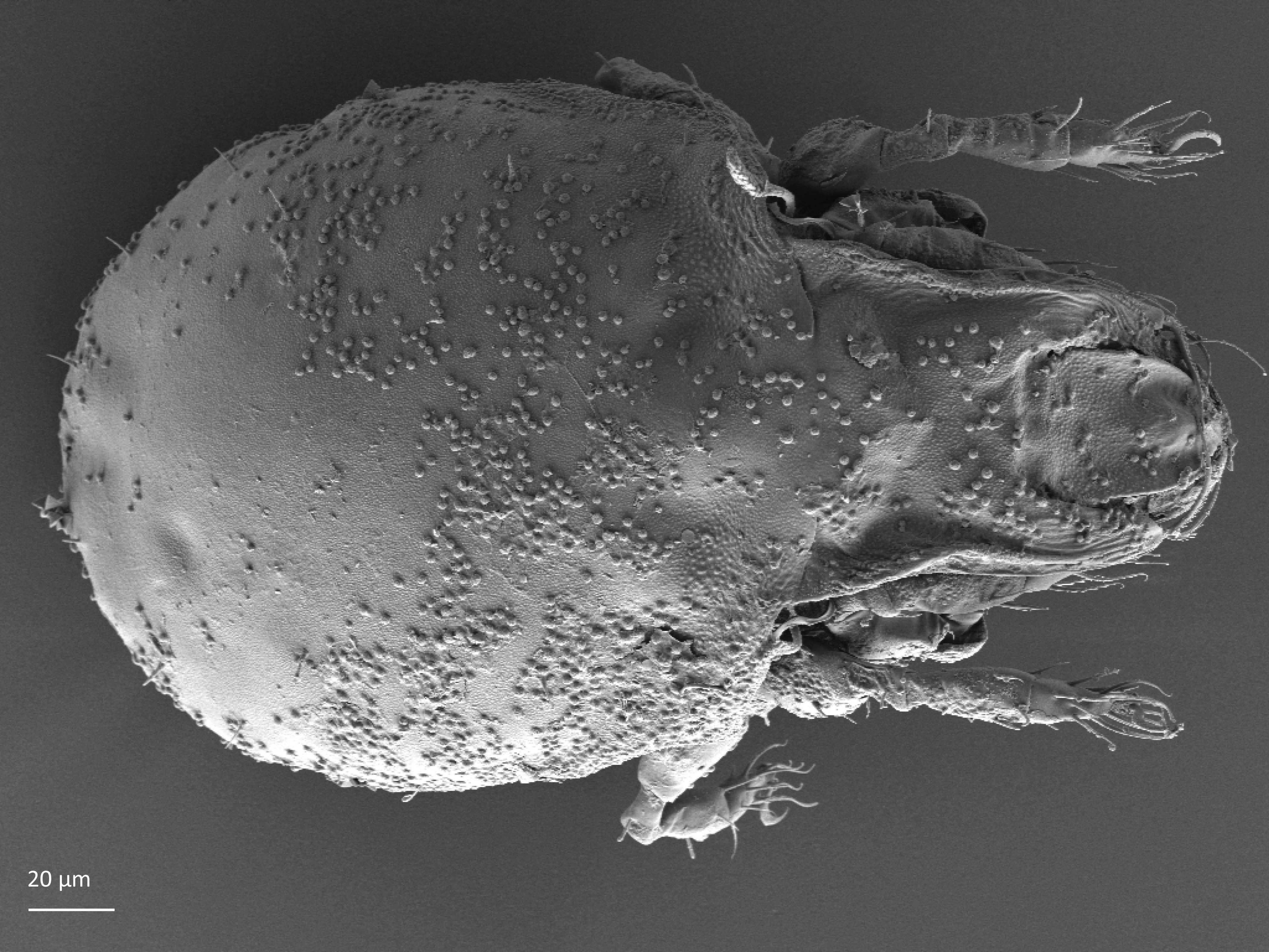Tectocepheidae
The family Tectocepheidae has a worldwide distribution and is one of the most common groups found in many habitats. These mites are pioneers and colonize barren or disturbed habitats.
- Innhold
- Characteristics
- Habitat and ecology
The family Tectocepheidae includes two genera, 17 species and four subspecies (Subías 2023). In Norway, only the genus Tectocepheus Berlese, 1896 is present.
Characteristics
The adults are small (225–300 µm long) and brown. Their cuticle has characteristic granular cerotegument. The prodorsum has lamellae and long lamellar cusps, but translamella can be present or absent. The notogaster does not have a distinct border, but it has a pair of small pteromorphs and 10 (rarely 11) pairs of small notogastral setae. The legs have one claw (Weigmann 2006, Norton and Behan-Pelletier 2009, Behan-Pelletier and Lindo 2023).
Habitat and ecology
Some Tectocepheidae species, like Tectocepheus velatus (Michael, 1880) described here, are relatively eurytopic, which means that they occur in many different habitat types and are often numerous. They are found in moist to dry grasslands, in soil and litter of forests, heathlands, peatlands, and in ruderal habitats (Weigmann 2006). Tectocepheidae is among the earliest colonists of post-industrial dumps (Skubała 2004) and of new soil exposed by retreating glaciers (Hågvar et al. 2009).
The mites of this family are parthenogenetic (Maraun et al. 2019), which means that only females are present, and they are produced from unfertilized eggs. The time of development of two species has been studied in the laboratory (Pfingstl and Schatz 2021). The development from egg to adult lasted 102 days at 25° C in Tectocepheus sarekensis (Trägårdh, 1910) and in Tectocepheus velatus (Murphy and Jalil 1964), and 57–72 days at 16-20° C in Tectocepheus velatus (Grishina 1991). In the field conditions in Norway the development of Tectocepheus velatus from egg to adult lasted over two years (Solhøy 1975).
References
Behan-Pelletier VM and Lindo Z (2023). Oribatid Mites. Biodiversity, Taxonomy and Ecology. CRC Press, 508 pp.
Grishina LG (1991). The duration of oribatids (Sarcoptiformes, Oribatei) life cycle. Siberian Biological Journal 1991(3), 38–47. [in Russian]
Hågvar S, Solhøy T and Mong CE (2009). Primary succession of soil mites (Acari) in a Norwegian glacier foreland, with emphasis on oribatid species. Arctic, Antarctic, and Alpine Research 41(2), 219–227. doi.org/10.1657/1938-4246-41.2.219
Maraun M, Caruso T, Hense J, Lehmitz L, Mumladze L, Murvanidze M, Nae I, Schulz J, Seniczak A and Scheu S (2019). Parthenogenetic vs. sexual reproduction in oribatid mite communities. Ecology and Evolution 9(12), 7324–7332. doi.org/10.1002/ece3.5303
Murphy PW and Jalil M (1964). Some observations on the genus Tectocepheus. Acarologia, fascicle hour series, C. R. ler Congres Int. d’Acarologie, Fort Collins, Col., U.S.A., 1963, 187–197.
Norton RA and Behan-Pelletier VM (2009). Suborder Oribatida. In: GW Krantz and DE Walter (eds.). A manual of Acarology, 3rd ed. Texas Tech. University Press Lubbock, 430–564.
Pfingstl T and Schatz H (2021). A survey of lifespans in Oribatida excluding Astigmata (Acari). Zoosymposia 20, 007–027. doi.org/10.11646/zoosymposia.20.1.4
Skubała P (2004). Colonization and development of oribatid mite communities (Acari: Oribatida) on post-industrial dumps. Wydawnictwo Uniwersytetu Śląskiego / Uniwersytet Śląski w Katowicach (UŚ). 206 pp.
Solhøy T (1975). Dynamics of Oribatei populations on Hardangervidda. In: FE Wielgolaski (ed.). Fennoscandian Tundra Ecosystems, Part 2, Ecological Studies. Analysis and Synthesis. Springer, Berlin-Heidelberg-New York, 17, 60–65.
Subías LS (2023). Listado sistemático, sinonímico y biogeográfico de los Ácaros Oribátidos (Acariformes, Oribatida) del mundo (1758−2002). Graellsia 2004, 60 (número extraordinario), 3−305. Updated 2023 – 18 actualization, 540 pp., access December, 2023.
Weigmann G (2006). Hornmilben (Oribatida). Die Tierwelt Deutschlands. 520 pp. Vol. 76, Goecke and Evers, Keltern.
